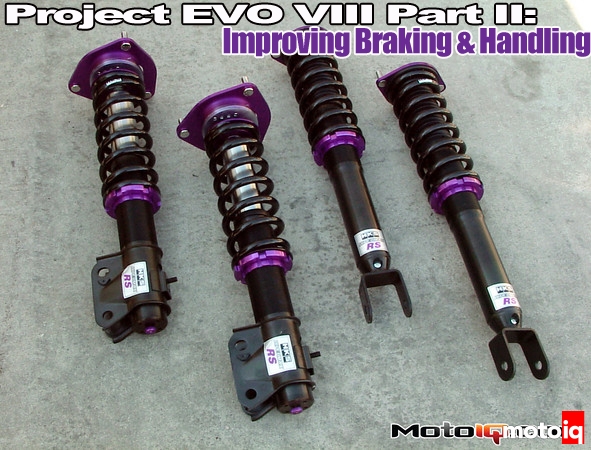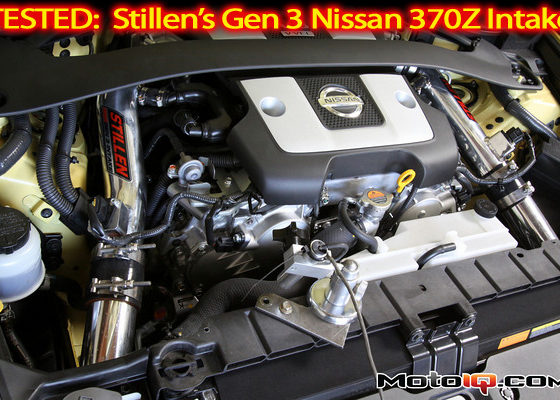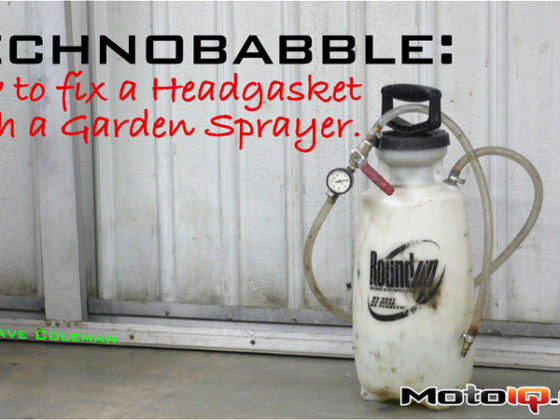,
The general construction of the EVO’s suspension is amazing. The suspension links are all constructed of strong light and stiff forged aluminum. The rear suspension is multilink and most of the rear suspension pivots in spherical bearing that are sealed against the elements and float in a thin layer of hard rubber for noise isolation. There is little sticksion, little flex in the wrong direction and long life to boot. It’s just about impossible for the aftermarket to improve on these pivots. However the rear trailing arm bushings have a huge gushy rubber front pivot and the front lower control arms pivot in soft rubber. These bushings are probably concessions toward ride comfort.
 |
| The front EVO Energy Urethane bushings are stiffer than the stock bushings that have these flex inducing air gaps |
To help hold our wheel geometry inline with our newly installed bigger stickier tires, while not making the ride spine compressing, we replaced the non-bearing gushy rubber pivots with hard polyurethane parts from Energy Suspension. The Urethane bushings were used for both lower control arms bushings, the rear suspension trailing arm and the front antisway bar. When installing the big front lower control arm bushing, it is necessary to chamfer the lower control arms hole with a .200” radius or it’s almost impossible to press the bushing in. The instructions say to merely chamfer the control arms holes lead in. We just lightly chamfered the hole but were not able to get the bushing in. We slowly removed more and more material until the bushing popped in.
 |
| The front EVO Energy Urethane bushings are stiffer than the stock bushings and replace all of the rubber in the front suspension |
We also installed Energy’s bushings in the differential carrier and differential moustache bar. These hard bushings will help prevent any wheel hop that our sticky tires may create on launch or when powering hard out of a corner by greatly reducing differential movement and wind up. Getting rid of this will greatly extend the life of other drivetrain components. Unlike other hard differential bushings the Energy’s urethane parts didn’t transfer any more noise or vibration into the cabin.
 |
| The rear EVO Energy bushings replace the only soft bushings in the rear suspension, those in the trailing arms and differential carrier |
 |
| The EVO suspension arms and differential carriers with the Energy bushings installed |
Once we installed our suspension, we drove Project EVO to West End Alignment, the best damn chassis shop in town to have Darren Nishimura align the car. Darren is well known in the local So Cal road racing scene as well as too many owners of hot street cars as the guy to have your chassis set up by. Darren set our front camber at 2 degrees negative, and the front toe slightly out. The rear camber was set at 1.5 degrees negative with zero rear toe. Darren also set the corner weights for zero cross weight with 200 lbs in the drivers seat. We also set the front Hyperdampers at 25 clicks, nearly full stiff and put the rear shocks at 20 clicks. We set the rear Cusco bar in the middle setting for now as well to keep close to the stock balance between front and rear roll stiffness.
We are very impressed with this setup. The Hyperdampers ride with less harshness than the stock suspension yet still resist roll. The nice compliance of the EVO’s rally bred suspension is still there since the dampers short bodies still have ample wheel travel but body roll is reduced by over 50% to slightly less than stock, even with the sticky tires. The EVO’s precise steering is even more precise, razor sharp; turn in is fantastic and the car only understeers with the most ham fisted wheel motions. Oversteer is provokeable but the cars natural balance is about neutral. Our setup will probably work for both autocross and road course work, which is unusual. EVO’s outfitted with fat R compound tires of the same size as ours will desire a stiffer more race oriented suspension but our setup cannot be beat for total street and weekend warrior track dominance. It clearly enhances the EVO’s strong points without turning it into a nervous and jingly track only car. We can’t wait until the next NASA HDPE open track event to see how many supercars we can embarrass with this little giant killer. The only bad thing to us is now the cars cornering limits are so high, perhaps higher than any street car we have ever driven, we cannot safely probe the cars capabilities on the street, the final setup will have to be determined on the track.
Brakes
The EVO comes stock with amazing brakes. Big 4-piston front and 2 piston rear Brembo calipers clamp big rotors. With Brembo’s all around, the stock EVO brakes are better than many upgrade kits right from the factory. The stock brakes are nice looking and powerful, nearly impossible to fade on the street and difficult to fade on the track. Increase the grip with significantly bigger tires like we did and fade becomes a possibility, although not a huge problem, we did notice a decline in pedal feel and an increase in pedal effort when pounding around the track. Some problems we noticed with the stock brakes were that the stock pads were noisy, and wore the stock rotors quickly to boot. Stock replacement pads were also expensive from the dealer.
 |
| The front Project Mu EVO rotors have pillar vanes for improved cooling, a special black heat treatment that improves harness, warp resistance and wear with a light weight aluminum hat for lighter weight |
 |
| The front Project Mu EVO rotor pillar vanes as seen from the top |
We wanted to enhance our brakes to keep them steady and consistent. The trick EVO’s Brembos did not need serious upgrading but we did tweak them in the interest of reduced fade and better pedal feel and modulation. We replaced our front rotors with Project Mu’s two-piece front rotors. The rotor is pillar vented which has more interior fin area, which dissipates heat better than the stock Brembo vane type vents. Pillar venting is also makes for a lighter rotor. The rotor is also grooved on the outside, which allows hot vaporized brake pad material to escape preventing the pads from hydroplaning on the layer of vaporizing pad. This does the same thing as drilling the rotors but without the risk of cracking like drilled rotors tend to do. The slots also give water a place to escape for wet braking, helping out first stops after a puddle in cold wet weather. The rotors also have a special heat-treating hardening process for longer life with harder more aggressive brake pads and increased warp resistance. To top it all off the rotors center part is machined of aluminum alloy and anodized blue to reduce heat transfer to the hub bearings and to remove several pounds of rotating and unsprung weight from the rotor.
 |
| The Stillen rear EVO rotors are pillar vaned for better cooling and lighter weight and are heat treated for warp resistance and longer life |
 |
| The Stillen rear EVO rotors have thermal paint stripes to determine the operating temperature |
For the rear we used a trick rotor from Stillen. The Stillen rear rotor features pillar vanes like the Project Mu rotor to improve cooling and reduce weight. They are also heat treated to improve wear life and to reduce the chance of warping. They are also slotted and have an integral drum to be perfectly compatible with the stock drum parking brake. The rotors feature rust and heat resistant paint on the hub and inside the rotors vents to resist rust and have stripes of temperature sensitive paint so the rotors operating temperature can be determined. This is very useful when selecting brake pad compounds.
 |
| Project Mu HC+ EVO pads are race pads that work well enough when cold to see some light street use |
For brake pads, Mackin Industries supplied us with some Project Mu Type HC+ pads, which feature a wide temperature operating range. We were assured that these pads would be more fade resistant than stock while running quiet with less dust and longer life. We noticed that the pads squealed slightly for the first couple of stops when cold but then were noiseless. The Project Mu’s also required slightly more pedal effort at first when cold but it was just a minor irritation, having a pad that dusted less was worth that tradeoff alone. The HC+ pads provides a steady coefficient of friction up to 800 degrees.



